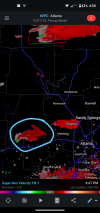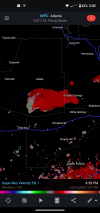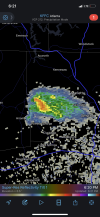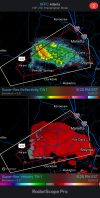Z
-
Hello, please take a minute to check out our awesome content, contributed by the wonderful members of our community. We hope you'll add your own thoughts and opinions by making a free account!
You are using an out of date browser. It may not display this or other websites correctly.
You should upgrade or use an alternative browser.
You should upgrade or use an alternative browser.
Severe New Years Severe Weather Event
- Thread starter Snowfan
- Start date
Z
Zander98al
Guest
Z
Zander98al
Guest
Stay safe!i had no idea there was supposed to be bad weather today now im under a tornado warning
must be a very very small storm because i dont even see a single cloud in the skyStay safe!
BufordWX
Member
Confirmed tornado in Walton county near Social Circle.
NBAcentel
Member
BufordWX
Member
I'm currently in Kennesaw and got the warning on my phone ?Super shower with a sick hook View attachment 100403
Yep, they are poppin! Poor Glenn Burns, it seems he's the only one working right now on WSBTV. Hopefully these storms will be short lived and not very intense. Ya'll be safe!!
Z
Zander98al
Guest
That's the weakest shower With a tornado warning I've ever seen lol
Snowflowxxl
Member
I just got a notice that I am under a tornado warning?!!! What the hell is going on
BufordWX
Member
Trees fallen on structures with storm coming into Marietta per FFC.
Snowflowxxl
Member
Dead still with barely an clouds here. I’m in the south end of the warning
Looks like it’s falling apart
Darklordsuperstorm
Member
If we are getting this much activity today im not sure I wanna know whats gonna happen tomorrow
BufordWX
Member
Per FFC for Cobb county storm.
SOURCE...Weather spotters confirmed tornado. These are very abnormal
storms for this area, but spotters have confirmed sighting
the tornado near Powder Springs and tornadic damage has
been reported.
SOURCE...Weather spotters confirmed tornado. These are very abnormal
storms for this area, but spotters have confirmed sighting
the tornado near Powder Springs and tornadic damage has
been reported.
Dewpoint Dan
Member
I'm confused about what is abnormal about it ? This is one of the most tornado prone areas of GA.Per FFC for Cobb county storm.
SOURCE...Weather spotters confirmed tornado. These are very abnormal
storms for this area, but spotters have confirmed sighting
the tornado near Powder Springs and tornadic damage has
been reported.
BufordWX
Member
There is practically no rain at all. That is pretty abnormal.I'm confused about what is abnormal about it ? This is one of the most tornado prone areas of GA.
NoSnowATL
Member
Very weird stuff
BufordWX
Member
Cobb county warning expired.
It's like popcorn. They pop up and then pop down really quick. It's gross out in Dacula where I am right now. I just hope everyone stays safe tonight and tomorrow thru Sunday!
BHS1975
Member
Maybe because it's a summer like air mass with winter like dynamics?
Sent from my iPhone using Tapatalk
Sent from my iPhone using Tapatalk
Ron Burgundy
Member
Crazy. We had a brief spin-up very similar to this 10-12 years ago as I was heading to the Peach Bowl. The funny thing is I was thinking how similar the sky looked to that event tonight and it didn’t even cross my mind it was going to actually produce.Per FFC for Cobb county storm.
SOURCE...Weather spotters confirmed tornado. These are very abnormal
storms for this area, but spotters have confirmed sighting
the tornado near Powder Springs and tornadic damage has
been reported.
Snowflowxxl
Member
I saw the warning pop up while I was watching the Alabama game and thought it was an error because the radar was a light shower.
Z
Zander98al
Guest
I think it's just the storms riding along the warm front which is aiding in rotationMaybe because it's a summer like air mass with winter like dynamics?
Sent from my iPhone using Tapatalk
thanksgivingbrown
Member
That’s what I was thinking. Everyone stay alert tomorrowIf we are getting this much activity today im not sure I wanna know whats gonna happen tomorrow
NoSnowATL
Member
He just want to push his agenda. GW TrollI think it's just the storms riding along the warm front which is aiding in rotation
Z
Zander98al
Guest
Lol what?He just want to push his agenda. GW Troll
BHS1975
Member
He just want to push his agenda. GW Troll
Nope just stating facts. Your putting words in my mouth.
Sent from my iPhone using Tapatalk
NoSnowATL
Member
SureNo just stating facts.
Sent from my iPhone using Tapatalk
BHS1975
Member
Sure
We've got low 70s dews almost to Tennessee. That's one hell of a warm from for WINTER.
Sent from my iPhone using Tapatalk
Z
Zander98al
Guest
There isn't, near the gulf coast right now you would be lucky to have thatWe've got low 70s dews almost to Tennessee. That's one hell of a warm from for WINTER.
Sent from my iPhone using Tapatalk




